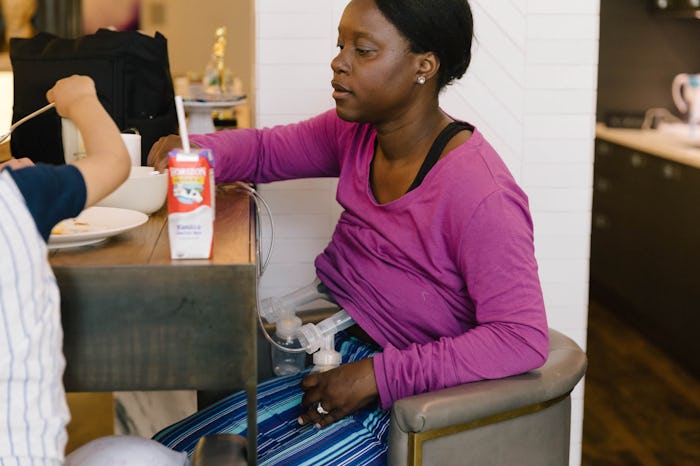Most breastfeeding moms worry about not producing enough milk, but there is a flip side to every story. Sometimes moms produce too much milk, which may sound nice, but can be difficult and painful for both mom and baby. If you are pumping and are worried that you're producing more milk than you should, you might wonder, can I pump without creating an oversupply?
It's funny to think that moms would want to decrease their milk supply, but when there is an oversupply, it can cause a whole range of annoying (and painful) symptoms. According to La Leche League International (LLLI), oversupply can lead to a painful latch, pain in the nipples and breasts, baby choking or coughing during feeding, plugged ducts or mastitis, and can even cause babies to be gassy or have explosive stools. So whether you're exclusively pumping or not, an oversupply can be stressful for you and your baby.
Romper asked International Board Certified Lactation Consultant (IBCLC) and registered nurse, Angie Mann Natero, to weigh in on pumping causing an oversupply. She says that it's important to remember that milk supply is driven by milk removal, which includes pumping, and that if you pump too early, when it isn't necessary, or if you pump too often, you could potentially create an oversupply of milk.
Natero says that she often recommends moms avoid pumping in the first three weeks, as long as breastfeeding is going well. "After that, if they desire or need to pump, they might pump once a day after the first morning feed, just to put a little bit back for their anticipated time away from baby."
What I learned from breastfeeding my two kids was that your body will make as much milk as it is asked. The more you pump or latch your baby on, the more cues you send to your body to produce milk. While traveling, I would add a few precautionary pumps to my schedule, but would end up with an oversupply, causing me to spray my poor baby in the face.
LLLI suggested that if moms do have an oversupply, they should breastfeed on one breast for each feeding, and offer that same side for at least two hours until the next feeding. They also noted that pumping and then feeding on one breast could help reduce supply, and that hand expressing milk could help ease some of the pain and pressure.
The bottom line is, the more you stimulate your nipples, with the baby's latch or a pump, the more milk you will produce. Skipping a pumping session, or putting extra time between feeding and/or pumping sessions can help prevent your body from creating an oversupply. Which means it's also preventing your baby from a jet stream of breast milk in the face.
